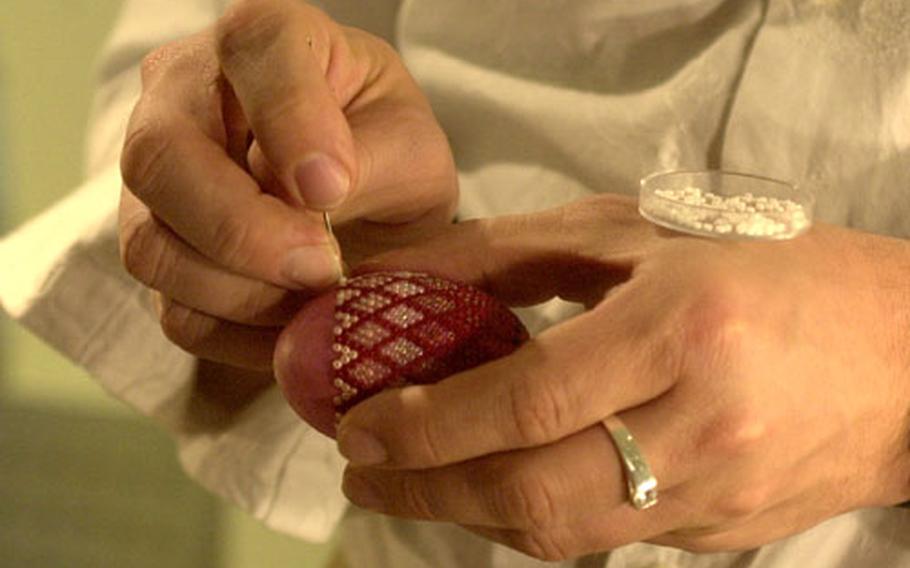
Helmut Meister carefully applies miniature glass pearls to a wax coated egg at a recent Easter Egg market. (Michael Abrams / S&S)
You can do a lot with an egg. You can boil it, fry it, poach it or scramble it. But because it’s Easter time, chances are you might be coloring it.
Depending on artistic abilities, this can mean simply dropping an egg in dyes of red, yellow, green and blue. But there is so much more that can be done.
The eggs can be covered with colorful beads, or hollowed out and perforated. They can have lace worked around them, or cut-out silhouettes pasted on them. They may be covered with wax and then have exquisite designs etched into them with a sharp blade. Or they can wrapped in patchwork, covered with written messages or painted, appropriately, with Easter bunnies.
And the eggs don’t have to come from a chicken, either. They can be quail eggs, duck eggs or goose eggs. They can even be huge ostrich eggs. You can find these works of art at Easter egg markets that sprout up like tulips across Germany this time of year. Known as an Ostereiermarkt, the market is usually held on the weekends leading up to Easter. Sometimes it is a small affair with local artists, but often it is an international event, hosting up to 80 artists.
The finished eggs do not necessarily come cheap.
True, you can find some beautiful ones for as little as 6 euros, but one can also find eggs decorated with gold that cost close to 1,000 euros. You can find a great variety of eggs, though for a reasonable price, say between 10 and 24 euros.
They make unique presents for friends or family back home. Or you can start your own Easter egg collection.
The Egg and You
Following is a selection of Easter egg markets in Germany and surrounding countries.
Austria
April 5-20: Vienna. Along the Freyung.
Germany
Through April 21: Sonnenbühl-Erpfingen. In Easter Egg museum.
March 22-23: Erlangen, 10 a.m.-6 p.m. Saturday, 10 a.m.-5 p.m. Sunday. Bohlenplatz community center.
March 22-23: Hering (between Darmstadt and Babenhausen), Saturday and Sunday. 11 a.m. to 5 p.m. Museum Veste Otzberg.
March 29-30: Hering (between Darmstadt and Babenhausen), Saturday and Sunday 11 a.m. to 5 p.m. Museum Veste Otzberg.
March 29-30: Michelstadt, noon-6 p.m. Saturday, 10 a.m.-6 p.m. Sunday. Odenwaldhalle.
March 29-30: Neckarsulm-Obereisesheim, 11 a.m.-6 p.m. Festhalle.
March 30: Augsburg, 10 a.m.-5 p.m. Kongresshalle.
April 4-6: Leipzig, night market. Rathaus.
April 5-6: Hallgarten, 11 a.m.-6 p.m. Kellerhaus.
April 5-6: Karlsruhe, 10 a.m.-6 p.m. Saturday, 10 a.m.-6 p.m. Sunday. Naturkundemuseum.
April 5-6: Ulm, 10 a.m.-6 p.m. Saturday, 10 a.m.-5 p.m. Sunday. Haus der Begegnung.
April 5-6: Hering (between Darmstadt and Babenhausen), Saturday and Sunday, 11 a.m. to 5 p.m. Museum Veste Otzberg.
April 11-13: Amöneburg-Mardorf (Hessen), 2-6 p.m. Friday, 10 a.m.-6 p.m. Saturday, 10 a.m.-5 p.m. Sunday. Bürgerhaus.
April 12-13: Michelstadt, noon-6 p.m. Saturday, 10 a.m.-6 p.m. Sunday. Museum in the Rathaus.
April 12-13: Hering (between Darmstadt and Babenhausen), Saturday and Sunday, 11 a.m. to 5 p.m. Museum Veste Otzberg.
April 18-21: Wartburg-Eisenach, 10 a.m.-5 p.m. Sonderausstellungsraum (special exhibition area).
Switzerland
April 4-6: Wolfwil (40 kilometers from Basel), 3-7 p.m. Friday, 9 a.m.-7 p.m. Saturday, 9 p.m.-5 p.m. Sunday.
— Compiled by Susanna Barnwell